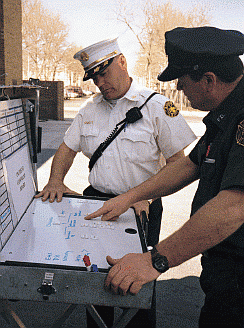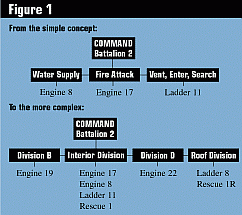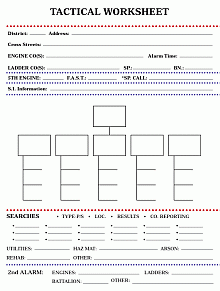Articles
Menu
- Promotional Assessment Centers, Understanding the process
- Lifeline Search: A Systematic Approach
- SCBA Basics
- Yankee Gutters: The Hidden Danger
- Tools For Managing The Incident
- Roof Operations: Listen, Look and Cut
- False Peaks: Help or Hindrance to Firefighting Operations?
- Water Supply: The Operating And Supply Pumper Concept
- The Jersey City Effort
- Size-Up: Updating An Old Acronym
- Jersey City Waterfront Triage
- Fireground Size-Up For Factory and Warehouse Fires
- Fireground Size-Up: Row Frames
- Fireground Size-Up For Garden Apartments And Townhouses
 Tools For Managing The Incident
Tools For Managing The Incident
In the never-ending quest to achieve more efficient, more effective, and safer operations, each department must design, develop, and use the tools that will best suit its needs. What works well for some may not work as well for others. In congested urban and suburban areas, for example, incident commanders may have to contend with and manage companies literally coming into an incident one after another.
In smaller towns or cities, it might be some time before a complement of companies arrives and is ready to go to work. Some may consider it a luxury to have a number of companies responding to an incident one right after the other. And, they are right. But it can also be a disaster if all those companies coming in together are not managed and controlled.
How many times have we seen firefighters logjamming the front doorway of a burning building? How many times have you yourself been on an overcrowded staircase or literally pushed into a burning room when functioning as the nozzleman? Well-managed and coordinated incidents should eliminate these scenarios. Firefighters are action-oriented by nature and, in the blink of an eye, all these people can and will go to work if allowed to. The concerns are that they will work in concert with the incident commander`s objectives and that the commander will be able to account for them.
In Jersey City, four engine companies, two ladder companies, a rescue company, and a battalion chief are dispatched to a reported fire. When the first-arriving unit reports a “working fire,” an additional engine company as well as a FAST unit (rapid intervention company), a mask service unit (air supply unit), a safety officer, and a deputy chief are also assigned.
Before the arrival of the deputy chief, the battalion chief manages all these responders and puts them to work if the situation calls for it. In Jersey City, these personnel respond within seconds to a couple of minutes of each other. The reason for this is that the stations are geographically located throughout the city to meet the loss potential that can occur in this densely populated city, which has an estimated population of 300,000 within 13 square miles. Numerous multiple dwellings of every imaginable type, age, and condition sit very close to each other. A little hesitation here, as in many congested areas, and you have fire in three buildings.
In an attempt to better manage the “all-hands” fire (four engines, two trucks, and the rescue all going to work) a few years back, I researched tactical worksheets. I came across some very good and detailed ones, but I soon found out as I tried to use them that they had too many areas to fill out. In some cases, the worksheet had me concerned with task areas that fall under the direct responsibility of the company officer, not the incident commander. The objectives were to use a method of assigning and tracking the resources with a worksheet that was also simple to use and effective. At this time, I also came to realize the limitations of the clipboard.
The clipboard was to be used to start the management process and was primarily to be used for the first alarm, all-hands fire. Fires greater than a first alarm in Jersey City require the deputy chief`s aide (incident management technician) to track the assigned resources with a larger command tracking board, and, depending on the size and complexity of the incident, the aid of a field communications unit. To put companies to work effectively, efficiently, and quickly for the first-alarm assignment, it came down to a personalized sheet of paper, a clipboard, and a grease pencil.
THE WORKSHEET: ALARM INFORMATION
It was easy to determine where to start. The assigned battalion chief references information generally in the order in which it is received. In Jersey City, we can receive alarm information one of three ways: from a voice alarm system in the fire stations, the fire department radio, or an alarm ticket from the department`s computer aided dispatch (CAD) system. Whatever the means, the information would be sent out in the following manner:
District/box number, address, and cross streets where the fire is reported; companies assigned to the incident; time of the alarm; and possibly any other specific information that can be useful and effective for that incident.
Specific Incident Information (SII). This area can be referenced from one of many sources. Information added in the department`s CAD can be printed out on the alarm ticket. Fire dispatchers can give it to responding units, or firefighters can reference it from a preplan book and write it down while en route. This area, as you can imagine, can be lengthy if you`re going to reference it and write it down. For that reason, it became useful to develop an abbreviation system that could tell the story, which should include the building`s height.
The Abbreviation System
- Construction Class
- Class 1–Fire Resistive
- Class 2–Noncombustible/Limited Comb.
- Class 3–Ordinary
- Class 4–Heavy Timber
- Class 5–Wood-Frame
- “Hybrids” Within the Construction Classes
- T/R–Truss Roof
- T/F–Truss Floor
- W/I–Wooden I-Beams, and so on
- Occupancy Type
- P/D–Private Dwelling
- M/D–Multiple Dwelling
- Com.–Commercial
- Mix.–Mixed Occupancy of Resid. & Com.
- E–Educational
- H/C–Health Care
- Dimensions of the Property -L x W or irregular shape
- Exposure Concerns
- Special – Open shafts, nonambulatory occupants, hazardous materials, and so on.
Example: An example within the Specific Incident Information area of the tactical worksheet of 3st. C/5 M/D 20 2 40 attached B&D sims states that the incident involves a three-story, Class 5/wood-frame multiple dwelling that is attached on the exposure B&D side by similar type buildings.
All of the above information is the critical section of your worksheet. Knowing where you are going, who`s going in with you, and maybe some useful information about the occupancy will greatly aid you in your decision making.
THE WORKSHEET: INCIDENT MANAGEMENT
 The incident management portion of the tactical worksheet simply uses the incident management grid system of a 1:5 span of control. With the box system, individuals can manage their incident with whatever incident management assignments are necessary to meet the needs of the situation. Companies may be assigned by task or geographically. The incident commander may use the system he prefers as long as his priorities are covered and his people are accounted for (see Figure 1).
The incident management portion of the tactical worksheet simply uses the incident management grid system of a 1:5 span of control. With the box system, individuals can manage their incident with whatever incident management assignments are necessary to meet the needs of the situation. Companies may be assigned by task or geographically. The incident commander may use the system he prefers as long as his priorities are covered and his people are accounted for (see Figure 1).
Keeping with the incident management concept, another helpful aid is to circle the company at the top of the worksheet and then bring it down to the grid/box section and assign it to the area in which you want it to work. The fire department unit at the top of the listed area is the company in charge of and responsible for that specific assigned area. Circling the company also allows the incident commander to track who is being used and who is still available. The grid system tracks where the firefighters are with a responsible individual for that area (see sample worksheet).
In addition, we felt we had to reference and keep track of the searches performed at the fire. The reasons for this were (1) to ensure that the priority areas are initially addressed, (2) to make sure all areas in question are searched in the primary and secondary modes, and (3) to eliminate unnecessary duplication of effort.
The Abbreviation System
The abbreviation system devised for the search section of the worksheet follows:
- The type of search being reported–primary (P) or secondary (S).
- The location of the search, specifically the floor.
- The results, whether positive (P) or negative (N).
- The company reporting the search.
Example: P/3 N L-11 stands for the primary search floor 3 is complete and negative from Ladder 11. A quick abbreviation reference tells the whole story in little time.
ADDITIONAL INFORMATION
 Other areas referenced on this particular tactical worksheet are the assignment of utilities, hazardous materials, arson investigation requests, as well as companies in rehab. At times, there also may be a need to request and put to work the second-alarm assignment prior to the arrival of the deputy chief, his technician, and the field communications unit. These people would still fall under the responsibility of the current incident commander and, if needed, they can be assigned and put to work from this sheet as well. The second-alarm companies responding to the incident simply can be listed on the bottom of the worksheet and then circled as they are assigned a geographical area.
Other areas referenced on this particular tactical worksheet are the assignment of utilities, hazardous materials, arson investigation requests, as well as companies in rehab. At times, there also may be a need to request and put to work the second-alarm assignment prior to the arrival of the deputy chief, his technician, and the field communications unit. These people would still fall under the responsibility of the current incident commander and, if needed, they can be assigned and put to work from this sheet as well. The second-alarm companies responding to the incident simply can be listed on the bottom of the worksheet and then circled as they are assigned a geographical area.
In our continued quest to effectively, efficiently, and safely manage our people with the means available to us, each department will continue to design, develop, and then revise what works best. As long as we keep the protection of the firefighter and the effectiveness of our people as our primary objectives, we will be sure to succeed.
